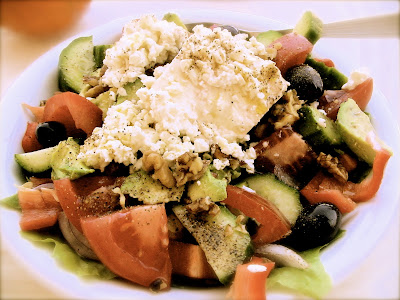
I'll never forget the first Greek salad I ordered, some years ago, sitting at a taverna under the shadow of the Acropolis in the Plaki neighborhood of Athens. "Why are all the vegetables literally
floating in all this olive oil? And where's the lettuce? And do they really expect me to eat this entire two pound block of cheese on top?"
That was back when, like most Americans, I had a huge fear of fat. Fat makes you fat, right? Any recipe that ever called for olive oil always stated to neatly 'drizzle' a teaspoon of olive oil over your salad, safely keeping your daily fat intake below your allotted 60 grams.
Now here I was staring down at my dinner, needing scuba gear to fish out my cucumbers and tomatoes from a sea of what I saw as a substance waiting to attach itself to my thighs. But that was then and oh how I've changed! Now I won't get started on what I believe is a misconception of fats we've adopted in our culture - that's a topic for a whole other blog - but what I will say, is that I eventually
had to get over this if I was ever going to live in a Mediterranean country that I soon realized consumes olive oil like water.
After returning from Greece to settle stateside, I've continued to consume olive oil in the same copious amounts as I did in Greece. I guess you could say I'm pretty much addicted to the stuff - not to mention a helpful 20 pounds lighter.
So with my first official recipe posting - the ever popular Greek salad - I would strongly encourage you to throw away your measuring spoons, pick up your favorite bottle of olive oil and
pour!
Traditional Greek Salad1 large English cucumber
2 medium sized tomatoes
1/2 green pepper
pitted Kalamata olives
Feta Cheese
sliced onion (optional)
dried oregano
sea salt
Ok, let's talk ingredients. When it comes to vegetables, you don't want to skimp on quality. I prefer English cucumbers or regular organic cucumbers to those waxy, water things they call a cucumber in most stores. English cucumbers are extra-long and firm and are the closest thing to what they use in Greece. I find most supermarkets sell these as well. Peel the cucumber and slice into rounds about a 1/2 inch thick and place in large glass bowl or plate.
As for the tomato, it can be quite difficult to find a good tomato outside of your own garden, especially in the winter, but it is essential to use a tasty tomato in this salad. Buy a couple different brands from your supermarket and see which one you like best and stick with it. Vine ripe tomatoes can also be a safe bet for flavor. Cut tomatoes in sections and sprinkle lightly with salt, then add on top of cucumbers.
Next, thinly slice the pepper in rounds and arrange on top of cucumbers and tomatoes. Sprinkle entire salad with the sea salt to your taste. I prefer Kalas Greek brand salt if you should happen to have a Greek market near you.
Oh cheese, how I love thee! When buying a good Feta, always look for one that is made from goat's milk as this is from what it is traditionally made. My favorite Greek brand of feta that is also sold in the US is Dodoni - if you can find it, get it. Now cut a huge chunk of the stuff - like half the size of a small paperback book - and place it on top of the salad.
Arrange the Kalamata olives around the salad, sprinkle a pinch of dried oregano on top of the cheese - and now
pour your favorite olive oil* all over the salad until you have at least enough oil sitting on the bottom to dip some fresh baked bread into while you're eating.
On a side note, I'm not a huge fan of mixing my leafy greens with other veggies and prefer to keep them in separate salads. However, if you feel adventurous or have some other veggies you want to use up, throw in some red pepper, avocado and walnuts and turn it into a hearty meal (see photo).
*For this salad I use Trader Joe's brand Kalamata oil. This is a fantastic Koroneiki varietal from the region of Kalamata in the South Peloponnese of Greece - and usually just under $8 a liter at Trader Joe's - a super value if you ask me!




